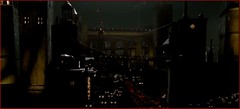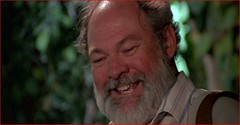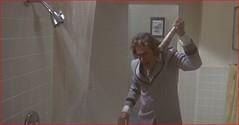
Instead of seeing Spiderman 3 this weekend, I spent my free time on a much overdue back-to-back viewing of the original King Kong and the extended edition DVD of the 2005 ape caper. For those counting at home, that's 305 consecutive monkey minutes. Some thoughts:
- What caught my attention the most when watching these two back-to-back is how much more effective a character Kong is in the original, when he is portrayed more as a juvenile creature, as opposed to the grumpy brute that stars in Peter Jackson's version. When we first meet the 1933 Kong, he's huge and terrible but has some kind of smile on his face, and he treats Ann carefully like a fragile toy. The 2005 Kong is capable of all sorts of realistic ape expressions, but kindness and glee don't seem to be in his arsenal -- maybe it's due to the fact that real apes cannot exactly portray these facial emotions, and as a result the new Kong never achieves that playful quality of the original.
- Indeed what makes the original movie so endearing is the sympathy you feel for the title character. When he gets shot down at the end, you see it as an innocent creature being tormented and unfairly killed. Kong earns this sympathy by never showing any malice, and coming off as a confused, youthful creature. Though he does wreck the train and throw an innocent woman to her death in New York, they can both be attributed to his frightened ignorance of this terrible new world he inhabits -- the train resembles the snake he fought on Skull Island, and the woman was the first Ann-like creature he found.
- Compare this to the personality of the 2005 Kong: he seems full of rage, and it feels like a miracle that Ann survived the night with him. In all his action sequences, Kong 2005 comes off as a juggernaut, taking on foe after foe with ease, while the original Kong was a clumsy fighter who got about as much as he gave. Whereas the original Kong instantly showed a connection to Ann (whether it be out of novelty or love), it's hard to tell just what value Ann holds to the 2005 Kong: he's obviously gone through many of these 'gifts' from the natives, and appears to be somewhat amused by her vaudeville antics, but all in all doesn't seem to be that smitten with her. In the original, we find Kong trying to impress Ann (picking flowers just before the snake attack) and obviously has a huge interest in her: Kong famously is delighted by her alien scent (he amusingly sniffs his fingers twice after brushing her hair), and takes interest in her strange clothes and foreign appearance.

- Jackson's Kong (especially in the 38-minutes longer extended edition) raises the action stakes to a near-unprecedented level and almost always exceeds your expectations in this regard. The tri T-Rex battle has to be one of the most thrilling action sequences in the past 20 years, and is easily my favorite of the CGI era. Sure, Lord of the Rings had epic battles and Spiderman 2's train battle is right up there, but we're talking about three ferocious dinosaurs against a 25-foot ape -- how can you top that? Purists can bash CGI effects all they want, but Weta Digital's are in a different league for the physical weight that is given to these monsters: every punch, crash and plunge feels like a few tons of bricks, never like a cartoon or video game. Credit Jackson too for creating the most frightening locale since Terminator 2's future Los Angeles war zone: the original Skull Island was pretty bad, but you want no part of the natural terror in Jackson's version.
- When did Hollywood get into the mindset of having summer epics be no less than 2 1/2 hours? Even though Jackson's Kong is only about 30 minutes longer than the original, it never settles into that movie's rock 'n' roll pace, due mostly to the lumbering first act. Too much screen time is devoted to setting the scene of the Depression era, and the relationships inside the boat. In the end, none of that matters -- it's all about Kong, Ann and Carl Denham. Jack Driscoll may play the part of heroic human love interest, but in both versions it's pretty hard to care about him (Ann seems to share this sentiment). Watching Jackson's movie, I couldn't help but wonder what it would have been like if it opened as the boat disembarked -- with all the introductory New York scenes excised. Exposition such as Denham's troubled film career and Ann's vaudeville background could have easily been explained en route to Skull Island, and starting the film off on the boat would have made it easier to digest all the action of the film's final two acts.

- As hard as it is to say, I think I prefer Jack Black's Denham to Armstrong's. Black's character gets off to a rough start with the clunky New York scenes, but once he gets to Skull Island the character is more realistic and three-dimensional than Armstrong's. The new Denham slowly starts to unravel once the carnage on Skull Island happens, which makes his dreams of grandeur more believable after Kong is defeated. Armstrong's Denham gives us little more than a doubtless showman, who has nothing but confidence in his plan of showcasing a monster to the world. Even when Kong routs his men, the 1933 Denham barely blinks, and at the end of the day on Skull Island he's the same man he was in New York. With Black's portrayal (and of course due in no small part to the direction of Jackson and his Lord of the Rings writing duo of Phillipa Boyens and Fran Walsh), Denham is clearly shaken by what happens on Skull Island and the brute force Kong is capable of -- the fact that he thinks he can safely showcase him in America sells the fact that he is now somewhat deranged.
- Credit Jackson for keenly keeping his movie in the world of fantasy and not trying to sell it as reality. The original Kong lived in fantasy: the Empire State Building is seen as a towering spire, fictitiously dwarfing the rest of the city; and we are given no reason to believe that Denham's ship could have carried a slumbering Kong back to New York. I loved how Jackson paid a shot-by-shot tribute to this latter bit of unrealism, as in both movies the story simply jumps from Skull Island to Manhattan with no mind given to how the giant ape was transported (a seemingly impossible reality, given the nature of Denham's ship and the fact that Kong would have had to sleep through the whole journey).
- Jackson's recreation of the infamous lost spider pit scene is one of the most generous extras to ever grace a DVD, but I think the original does fine without it. We don't need any more convincing that humans are no match for Skull Island's inhabitants, and the mere glimpse of that terrible half-lizard/snake thing crawling up from the chasm provides enough evidence that we have only seen a sliver of the island's natural terror.
- Another reason to cut more of the opening scenes from Jackson's movie: the newly restored swamp scenes on the DVD did not need to be cut. The water monsters we see (a huge catfish-like creature and many aquatic scorpion hybrids) are fantastic and terrifying, and would have enhanced the Skull Island adventure more than any of the early Denham/Ann scenes. Also, though I loved the bug pit scene -- what does it say about the MPAA that such intensity made it into a PG-13 movie? Not only is it a terrifying sequence, but the shot of a man being graphically eaten by huge worms is hugely grotesque and seems out of place in a movie many kids would be seeing. Long gone are the days when studios could afford a quick tit shot without an R-rating, but King Kong is a great example that more concessions are made toward gore and violence in PG-13 than ever before.












1 comment:
I like this compare/contrast piece. We did a similar back to back viewing a few months back though we included the Jeffrey Lebowski vs. the Petrolium Conglomerate 1976 version too. I'm onboard with most all of your observations and want to add one that struck me while watching. The 2005 remake is set in the time that the original film was released (the 1930s) while the original is set in its own time. I think that's an unfortunate decision for Jackson's version because it makes his film a costume picture and it tends to feel like a parody at times; I think his more realistic ape might work better in the present that in a faux-30s. Both films are thrilling fun, but for my money Cooper's take on Kong is alpha monkey.
Post a Comment